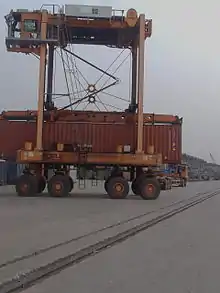Port of Mongla
The Port of Mongla is a link sea port, located at Mongla Upazila, Khulna Division, Bangladesh. It is a sea port of Khulna city which is located near to the north. It is the second largest and second busiest seaport of Bangladesh. Mongla port lies close to the shore of Bay of Bengal and Pashur river. Mongla is renowned among the major important ports of the Bengal delta. Due to the increasing congestion in Bangladesh's largest port in Chittagong, many international shipping companies have turned to Mongla as an alternative. Also the influence of continuous demanding from all over the country and neighbouring countries made it busier and economically eye catching day by day.[2]
| Port of Mongla | |
|---|---|
 A ship docked in Mongla | |
Click on the map for a fullscreen view | |
Native name | মোংলা বন্দর |
| Location | |
| Country | Bangladesh |
| Location | Mongla Upazila Bagerhat District, Khulna Division |
| Coordinates | 22°29′20″N 89°35′43″E |
| UN/LOCODE | BDMGL[1] |
| Details | |
| Opened | 1950 |
| Operated by | Mongla Port Authority |
| Owned by | Government of Bangladesh |
| Type of harbour | Artificial / Natural |
| No. of berths | 11 |
| Statistics | |
| Annual container volume | 100,000 TEUs (2019-20) |
| Website mpa | |
| Part of a series on |
| Transport in Bangladesh |
|---|
 |
| Modes |
| Aviation |
| Authorities |
|
| Public transits |
| Important infrastructures |
| Others |
Also some political and economical influence in Khulna region from the government also prevailing the development and demand of the port Mongla. Padma Bridge megaproject is a big example of those influence in Khulna region. Mongla is also a gateway for tourist ships traveling to the largest mangrove forest of world, the Sunderbans. It is also marked as a resource of UNESCO World Heritage Site. The port also hosts the Mongla Export Processing Zone (Mongla EPZ).
Bangladesh gives India permanent access to Chattogram, Mongla ports[3]
History

The port was founded in 1950 to serve the southwestern region of East Bengal. It was originally known as Chalna Port.[4]
Geography
It was formerly located at Chalna, about 18 kilometres (11 mi) upstream on the Pasur River but it is now located 48 km south of Khulna city, as established on 11 December 1954. The Port is surrounded and protected by the Sundarban mangrove forest.[5] The port is situated at the confluence of the Pasur River and the Mongla River. It lies about 100 km (62 mi) north of the Bay of Bengal. .
Port infrastructure
The port has 11 jetties and 8 warehouses. It uses 12 swinging moorings in deeper sections in the river. The port is connected by the Bangladesh Railway to the Khulna Metropolitan Area.
Ship services
In 2015–16, 636 ships used Mongla port.[6] Mongla is connected to most major ports in the world, particularly Asian ports. Hundreds of ships use the port each year, most of which come via Singapore, Hong Kong and Colombo. Mongla is also connected to most inland ports in Bangladesh, including the Port of Dhaka and the Port of Narayanganj.
Trade

The port is open for 24 hours and up to 225 metre long ships can enter into the port for discharging cargo. A constraint free large channel is available for anchorage and loading/unloading facilities on both sides for 33 ships at a time.
Future expansion
The government of Bangladesh has launched dredging and jetty construction projects to expand the capacity of Mongla port.[6][7]
References
- "UNLOCODE (BD) - BANGLADESH". service.unece.org. Retrieved 22 April 2020.
- "Bangladesh port expands as shippers avoid Chittagong". Joc.com. 5 June 2012. Retrieved 24 July 2017.
- Chaudhury, Dipanjan Roy (30 April 2023). "Bangladesh gives India permanent access to Chattogram, Mongla ports". The Economic Times. ISSN 0013-0389. Retrieved 4 May 2023.
- "Mongla Port". Banglapedia. Retrieved 24 July 2017.
- Mongla Port Authority - Other Information Archived 28 March 2012 at the Wayback Machine
- "Mongla port capacity expanding". Prothom Alo. Archived from the original on 14 August 2017. Retrieved 24 July 2017.
- "Bangladesh: Plan for Mongla Port Development Project Unveiled". Dredging Today. 4 July 2010. Retrieved 24 July 2017.